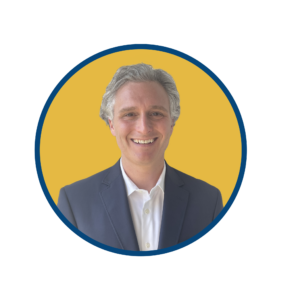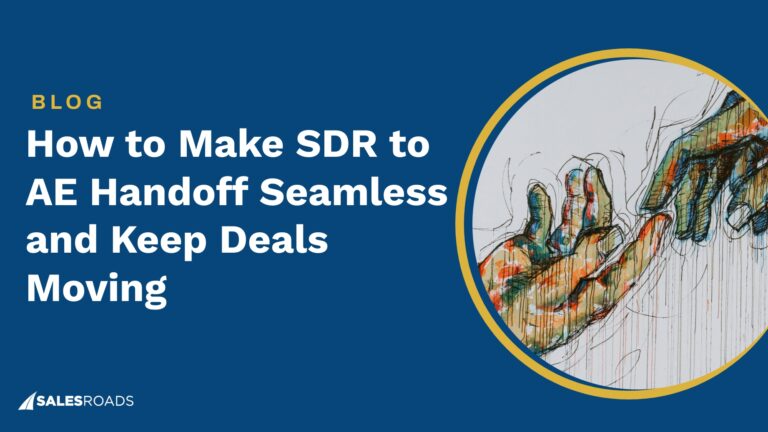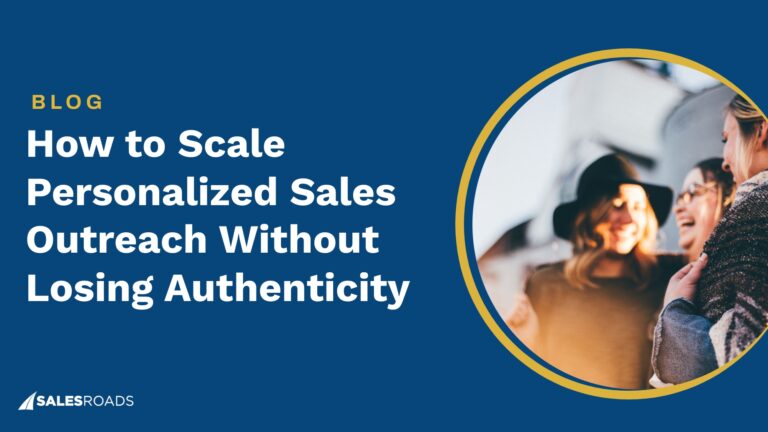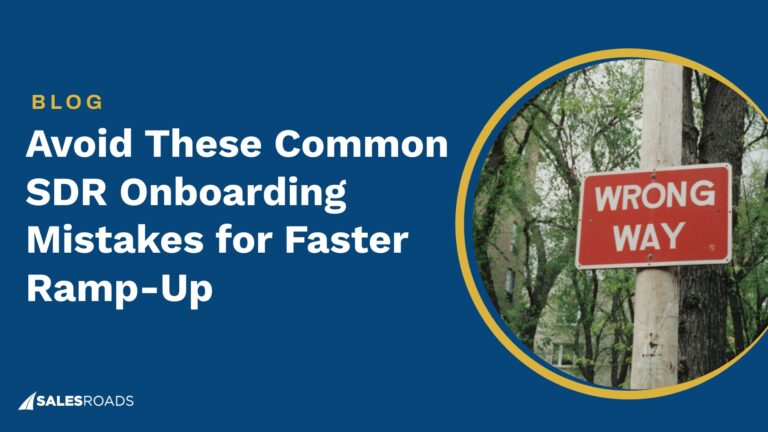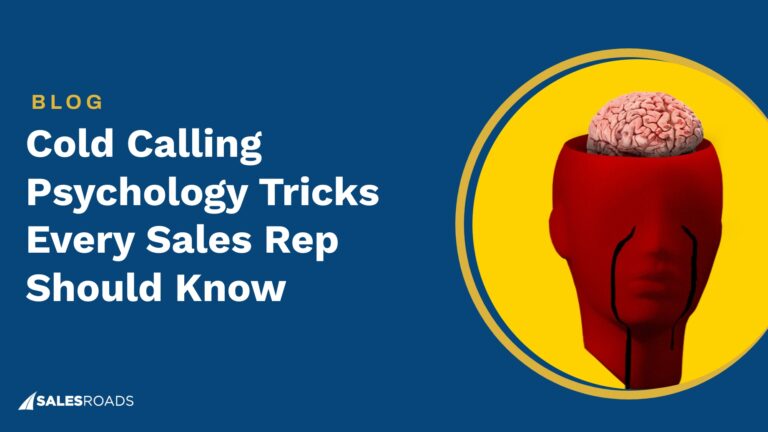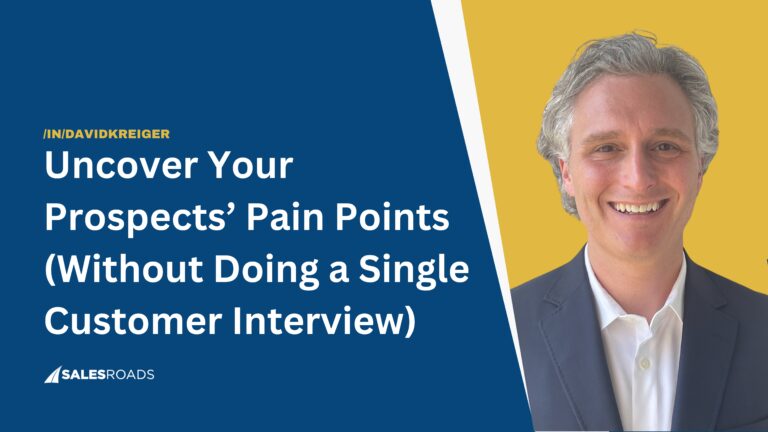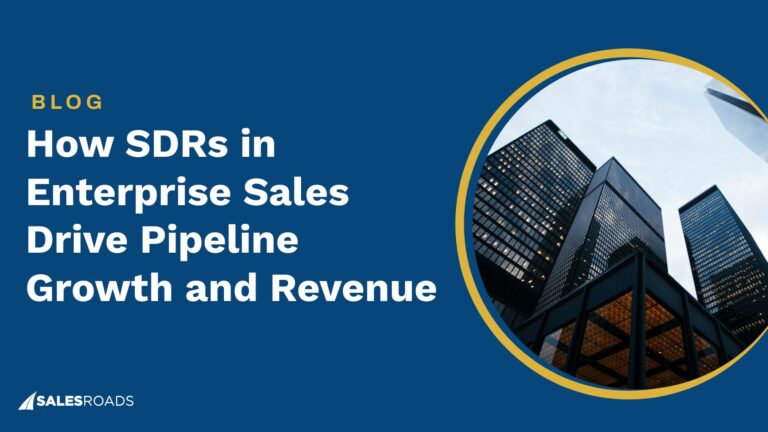Sell Like A Leader – Episode 19
In this episode, we dive into:
– The listening tour strategy: The importance of doing a listening tour when joining a new organization, how to implement a listening tour step by step, why you should follow it with a vision mission session, running in-person and virtual interactive planning sessions, gaining buy-in before implementing change, how to create ongoing feedback loops within a sales team to maintain alignment and motivation, and radical candor as a leadership principle.
– Rapid Fire Q&A
About Erin Dues
David Kreiger chats with Erin Dues, a seasoned sales leader with 13+ years of experience in technology and SaaS, incl. 9 years specializing in HR tech. As VP of Sales for Assessment and Succession within Korn Ferry’s Digital business unit, Erin is focused on expanding Korn Ferry’s talent technology solutions to a broader market. She has built high-performing sales teams at WorkTango, Asana, LinkedIn, and HubSpot.
Podcast Key Takeaways
- Erin highlights the importance of beginning your leadership journey with a listening tour to understand team dynamics and gain authentic insights firsthand.
- After gathering insights, marry your findings with a collaborative vision mission session, then craft a clear, actionable plan with mutual accountability to ensure alignment and buy-in from the team.
- Erin champions the use of radical candor, balancing care and direct challenge to drive growth and performance.
Connects
Connect with Erin Dues: https://www.linkedin.com/in/erindues/
Connect with David Kreiger: https://www.linkedin.com/in/davidkreiger
Subscribe to the podcast and follow our Podcast LinkedIn page so you don’t miss any episodes!
Transcript
David: Welcome back to another episode of the Sell Like a Leader podcast, the podcast for revenue leaders who are on a mission to cultivate high-performing sales teams. I'm your host, David Kreiger, president of SalesRoads, America's most trusted sales outsourcing appointment setting and lead generation firm.
And today I am bringing you a fantastic revenue leader, Erin Dues. Erin is a seasoned leader with over 13 years of experience in technology, SaaS, including nine years specializing in HR tech. She is now the new VP of Sales for Assessment and Succession with Korn Ferry's Digital business unit.
And so she's really focused on expanding their talent technology solutions. But before that, she has an impressive resume working for companies you have probably heard of, including WorkTango, Asana, [00:01:00] LinkedIn, and HubSpot. And so super excited to have Erin on the show today. Thanks for joining me, Erin.
Erin: Thanks for having me. Excited to be here.
David: Awesome. Well, you know, as we prepared for the show, we, um, loved the concept and your approach to cultivating high-performing sales teams with a listening tour. And so could you tell our listeners a little bit about what that means?
Erin: Absolutely. I love doing a listening tour anytime I join a new organization, whether it's a frontline sales leadership, whether it's second-line sales leadership, business unit, frontline, whatever it may be. I find it just to be super mission-critical in understanding the team dynamics from the ground up.
I typically go into organizations, most of us do, with a hypothesis, assumptions, observations that we'll have over the first couple of weeks or months, but it's really important to get to know the team at an authentic level and hear [00:02:00] their version of what's working, what's not, and marrying that with some of the observations you might have.
I think it just really gives you an opportunity to have first-hand insights, really validates maybe some of your hypotheses coming into an organization. I'd say the best part of it, it really creates this culture of openness and a connected culture from the get-go and really brings you close with the team.
David: Yeah, I love that. I think that sometimes, especially coming into organizations, sales leaders feel like there's this expectation that they should be bringing all these new ideas and all the things that they're going to change about the organization. And that's what they're being hired to do.
But I think to your point, it can, first of all, sometimes backfire—creating the wrong type of culture, creating the wrong types of relationships. But also listen, we bring acumen and our experiences from other places we've been to, but every place is unique.
And unless you really listen [00:03:00] to the folks who have been there, who are doing the day-to-day, it is really hard to bring around some of the changes that might be needed without listening and hearing from them first.
Erin: I think you bring up a really good point. If you are going to be implementing or instituting big change, having them on board and aligned is critical. And that listening tour can help you gain that buy-in.
You might be surprised how much they agree that change needs to happen or how much they might be seeing things in a different perspective. And it's really important that if you want to have strong change that you bring them along for the journey.
You know, a lot of the companies and a lot of the organizations that I've joined, change is inevitable. It's imminent. However, I don't like to make a change immediately. I think it's rule number 101—don't jump in and make change right away. Really take an opportunity to get to listen and get some trust and buy-in, then institute the change.
And at that point, you'll have a lot easier time to manage the [00:04:00] change management through that.
David: I think that's really important because I think it can be scary too. If you just start changing things on day one before you've built those relationships. To that point, I'm curious. How you're implementing these changes is to wait a little bit.
Once you're ready to make some of the changes, is there a certain technique or structure that you like to bring to the table, and how would you recommend that sales leaders actually plan to execute some of these listening tours and then the changes that they need to make?
Erin: So I think about it, I'm very methodical. I'm like type A, super big planner. So I go through my listening tour, and I'm happy to walk through what that entails. Then typically after the listening tour, I will marry it with a vision, mission powwow session with the team and the org, just to make sure that I bring together my learnings, make sure I didn't miss anything, get them bought in, get their feedback, get them saying, yes, we agree.
This is what we want to be known for. We agree. This is where we need to go as a business. And then from [00:05:00] there, I create a very clear action plan. And I basically call it our priorities. Okay. Based on what I heard, based on what we talked about, these are now our three priorities going into H2. And everybody is going to have mutual accountability.
And then what happens then is as you go through the change, and maybe it's a couple months down the line, maybe it's not meeting the expectations you wanted, you could say, hey, Bill or Bob or Joe, remember we talked about this is what we wanted to do. And what's changed now about your buy-in and commitment to this?
David: When you're doing the list, so let's break down each of the steps. So with the listening tour, is there a certain methodology? Do you meet with people one-on-one? Are you meeting with your direct reports? Are you meeting with everyone who's in the team? What's the methodology there for the listening tour?
Erin: Always first, either send an email, and the email is: this is who I am. You probably see me looming in the background. This is what to expect. And I'm very clear that I'm going to be scheduling a listening tour with each of you. And I give them a little insight. Then I actually pre-wire them [00:06:00] on that.
After, I will be bringing us all together for our first all-hands, our first team meeting, our first group gathering, where I will share with you what I learned. Then I will schedule 30 to 45 minutes. I do give prompts. I say things like, what is your perspective on the business? What's your start, stop, and continue?
How can I set you up for success? And I provide usually about five really clear, actionable questions for them to answer. However, it's very fluid. I don't make them answer it. I say, hey, listen, I provided some prompts, but I want this to be conversational. We can take this whatever direction you like.
Some people will get very tactical and say, these are the things that I'm struggling with. These are the things that I think we can do better. Some of them are very visionary. I think we need to look at a new go-to-market strategy or whatever it may be. I take copious notes. However, active listening is mission-critical.
So what I do is I will put everything on one screen, and I'll be taking notes. Then, as I notice really key themes happening, I'll write it down and say, this theme keeps coming up, and this is the theme that [00:07:00] keeps coming up.
And then I track those themes. I stay active listening, and then I consolidate it at the end. I always make sure I repeat back at the end and say like, okay, so let me just make sure I heard you correctly. These are the things that you find working well. These are the things that, if I could wave a magic wand, you would change.
And then I recap it from there. And then I just have a very in-depth notebook and list of questions, which I put into AI to summarize for me.
David: So first, I love that you send an email right away because it's hard to do a listening tour with everybody right out of the gate. But they get a sense that this is the way that you're coming into the organization, that you're going to be listening to them. That's got to be very empowering for them.
Though they're probably still a little nervous coming into those meetings. But I think that sets the stage really nicely from a cultural standpoint that this is what you're doing.
And then, I've found that some people might have the [00:08:00] right intentions and they'll listen and they'll do some of these things and they'll talk to people, but then they don't, like you said, do the active listening, or they're not really hearing it and they're going through the motions.
And I actually think that can be more demotivating if people open up and give ideas and give their opinions. And then they don't see it going anywhere, or at least if something they're passionate about, it may not be the direction that you've seen from listening to everybody else. It might not be the right direction, but at least going through and giving them some feedback on the feedback they gave you so it doesn't feel like it just was a waste of time.
So, how do you manage all that? Sounds like you use a lot of things to summarize it. But how do you then synthesize that information, filter it back to the folks, and then start building your strategic plan?
Erin: I love that callout because you obviously can't do everything. So one of the elements to that facet you just brought up, I make sure that I consolidate [00:09:00] everything, and I let them know they were heard through whatever mechanism.
So right now I'm actively going through a listening tour. And I have this very unaesthetically pleasing Excel, and I'm going to share with them, even though there are things in there that I won't be able to get to.
I will share all of it in an upcoming meeting and in all-hands and say, listen, these are 10 things that were highlighted to me. I think they're important, but I unfortunately won't be able to prioritize it this go-around.
Please know that I heard you and I am sharing this with whatever additional leadership and it will continue to be actioned. Now, as we evolve, if there are things we won’t be able to do, I just—I like to lead with transparency out the gates. I'm very clear. I will be open and honest. And what is, is what you get.
I do like to—you talked about like an action plan. Like, I'll take it and I'll put it into like our priorities. So, for example, let's say a theme that we identified was negotiation skills or discovery. We need to do like a discovery 2.0 training, understand how to get deeper pain points.
I will work with sales [00:10:00] enablement. We just have to have an evangelist on the frontline to make sure that they're helping show how you put these things into practice.
If there is something with—like our pitch isn't landing, people are finding it frustrating, too many different competing narratives, and go-to-market talk tracks—I’ll work with marketing to consolidate it. And then I'll run some sessions there. I think a lot of what I hear with any organization I join is demand gen.
I'll work with different cross-functional partners to create a "plays of the month" or some sort of outbound strategy to support it.
David: You have a robust way of putting this all together. First of all, I love the transparency of putting a sheet together and having everybody see it, and also get feedback from you on what is going to be prioritized or not. I think a lot of sales leaders are trying to leverage AI to help them, because that’s a lot of work, like what you just said. And you had mentioned you use AI for some things.
Are there any tips as part of this [00:11:00] or any methodology when you're aggregating all this data and information when you're setting up your role in a new organization that you've used that seem to have helped you in this process?
Erin: I would say I'm beginner to intermediate with AI. I think there’s really quick, easy ways to make it a life hack. I use ChatGPT just to consolidate everything. And so with those notes, I’ll plop it in there and say, "Please share with me the biggest themes you saw." Then as I refine what three focuses—what our three priorities will be out of all of the different ideas and thoughts and commentary that came about—I will ask AI or ChatGPT to be very specific: refine this, tell me more about what else I'm missing from what I put together from the listening tour that I just had.
And that's in the most simplistic way how I do it. And I look at it before I roll it out to the team to make sure it's in tip-top shape.
David: We've talked a lot about how you [00:12:00] start these listening tours off, how you distill the information, come up with your three priorities, present that back to the team. Every strategy, though, needs iteration. Things can be working, can be not working. Maybe also you need to give updates and whatnot.
How would you create feedback loops to both have continuous listening and learning opportunities, as well as to distill the feedback and have good communication with your team?
Erin: At just a very foundational level, I'm very much open open-door policy. Like I like to really ensure that I encourage active, real-time feedback, to me, to anyone. But to make sure that there's a cadence. I've learned—like I'm joining a lot of organizations with not a lot of structure, not a lot of operating cadence.
You have to have a cadence. So I will typically, with my leaders, I have a weekly one-on-one. I will have a monthly connect with the frontline sellers to make sure that, “Hey, what's on your mind? What's being heard?” I love to do QBRs—quarterly retrospects, look-forwards.
And then in those, making [00:13:00] sure that's an active discussion on, "Okay, what works? What's not working? What have we talked about?" and seeing what kind of consistent patterns emerge.
But I think the most important piece of that listening tour is making sure you're staying connected and engaged, following up on things, and keeping that ongoing feedback loop—making sure that people feel comfortable coming to you if something is continuing to be a challenge and not getting addressed in the right way.
David: So there's something you had mentioned earlier on—I want to dive into it. It's a little—it's obviously part of the listening tour—but it's more of a mentality and a culture that you want to create in the organizations. And so you had mentioned you believe in radical candor, being very radical transparency.
And so I'm just curious, what are some of the elements that you feel need to be in place to have radical candor and it be a positive for your team? And what does it mean to you?
Erin: Love that question. I think [00:14:00] radical candor is one of the most critical leadership philosophies, fundamentals out there. And it’s really—it’s about caring authentically and then challenging directly. The whole theme and concept of it is, you can’t challenge somebody without it coming across too brash if you don’t care about them authentically.
And you can’t over-care about somebody, not challenging to help them grow—otherwise you’re hurting their development.
So I think the most critical piece in order for it to be effective, trust has to be there. And that’s where the listening sessions come into play. You’re not building trust if you’re not listening. So I think that listening tour for me is like that jumping-off point. And then the follow-through—making sure that if something’s not going to be a priority, that I let them know, and then I’m consistently delivering on what I shared.
I think the trust it’s through vulnerability, modeling excellence. I think the challenge will lie in striking the balance. You can, I mentioned, be too directive and too challenging, where it doesn’t come across the authentic way. I think it’s also—like I said—you don’t want to care too [00:15:00] much to the point where you're not challenging them to grow and not helping them get better.
I also think in the most simplistic way, we can call radical candor "tough love." Like I say, it’s a tough love approach.
David: Yeah, and I think it’s a virtuous cycle. I think that by caring about people, you want to see them grow. By helping them to grow, you’re showing that you care about them. And when you don’t do both of those—or just either—it can fall flat.
And so I do like your perspective of how they go hand in hand. And that’s how you can drive a really strong culture and strong performance—by having that foundation of trust that translates into showing that you care through pushing them and helping them to grow. By not just saying everything’s great, showing them ways they can grow and ways they can improve.
Erin: Exactly. And I think the key word there is like the authenticity about it. I've seen leaders like try and pretend they care or try and push [00:16:00] themselves to have more empathy or engagement with the team—and it's just not there. So I think really making sure that you're spending the time to be authentic.
David: Yeah, that's awesome. So you talked about how you have your three pillars—I think priorities or pillars—that you come in with. And so I'm just curious, does that sort of fall into, and usually is it a different direction? Is it a different vision that people are seeing?
And if so, how do you rally them around that, as things were being done a certain way, and now this is our strategic direction?
Erin: I will do the listening tour. Then I marry that with a vision-mission session. Then I roll out like an all-hands, say, I heard this during our mission session, I heard this during the listening tour. Now these are our three priorities. That’s how I like plan it. And then really, it’s just—every quarter I touch base, "Okay, where are we at tracking against to where we are?"
And I just go back to the fact—listen, they will have told [00:17:00] me. If we all rallied around this, we all agreed during our mission session, this is what we wanted to do. It might be like, "Hey, we want to be known as the team that sells the highest amount,"—like the highest ASP opportunities.
So when I’m determining my priorities, it might be something like: we have to create an enterprise upmarket motion.
And then they'd be like, "Wait, I don’t want to do that." And I'm like, "You said you wanted to be the highest ASP." And so these are the things that marry into it.
David: Erin, as we come to the end of our episode here, what I’d love to finish up with is: How do you bring this all together? How do you create the mission, the vision that’s going to drive the company forward or your division forward?
Can you just walk us through how that works and how you create that?
Erin: I think that’s one of the most mission-critical parts to tying a bow on the listening tour and the listening session and making sure that now I've heard everyone and [00:18:00] I'm bringing this shared mission and vision, unifying the team around a centralized purpose. I do this through an interactive mission-vision planning session.
If I'm in person, which would be ideal, it's we get in a space, it's brainstorming exercises, it's small groups answering some different questions. And it's very collaborative. Virtually, which is, quite frankly, how I've had to do it the past couple of years, is I adapt by using collaborative tools, such as Zoom has a whiteboard.
I start out with three to five questions. What do we want to be known for? What are our gaps to get there? And I organize them into sections. And for example, I'll ask people just put up little collaborative virtual post-it notes under the section and asking everyone to participate.
The key there is, and I always like to lead it with, what do we know now? Because a lot of change that happens when you're coming new into an organization is likely something that they've already tried before.
And I feel like [00:19:00] as we think about how the market's changing and how we are evolving in SaaS and technology or other industries, it's really important to say, knowing what we know now about our business and the resourcing and what's within our control now about our team.
Who are we, what do we want to be known for, and what are our gaps to get there? You'd be surprised at how many big, really big themes come out of that. And then I make it structured, inclusive. And then that's where I consolidate the mission and vision, the things that I heard along with the listening tour.
And then I tie it. This final all-hands that I'll have where I say, hey, here's what I heard. Here's what we determined as a team. These are now our priorities going forward. And you have everyone rallied behind it. You said we wanted to be this. We talked about this. What has changed? And you really make sure that you are a cohesive unit going forward.
Yes.
David: This is just an awesome process, Erin. I think, as I said at the beginning, a lot of folks feel like they need to come in with all the ideas, with the [00:20:00] strategy. But when you do it the way that you propose, a number of things happen.
One, you learn what the nuances are at the organization that you didn't really know or understand before, which helps you to craft a more powerful strategy, and more powerful mission, more powerful vision.
But if anything, the most important thing is, like you said, to rally them behind you then, because it is much more empowering and motivating when you feel like you had a hand in crafting the strategy and the way forward versus being told what you need to do.
Erin: I think we jump in too quick as leaders sometimes. And we want to show we're valuable. We want to make the change. And you know what, I can't say that there's an organization that I joined where I didn't know what had happened. I had assumptions that were tested during listening sessions, but the buy-in is so critical.
And you're not going to get change, and you're not going to get adoption to change if you don't have the buy-in and the alignment and the trust.
[00:21:00] Are you going to be drinking from the firehose? Of course, yes. You're going to be inundated, but it's so important. And you can do them over the course of the first couple weeks, and then it just gives you that foundation to make sure that what you want to do and the change you're going to institute will be successful and adopted in the right way.
David: So perfectly said. That is awesome, Erin. And before we go, what I'd love to do is do rapid-fire questions. And so I'm going to ask you a few questions, and we just get your perspective or thoughts on the topic.
Does that sound okay?
Erin: Sounds great.
David: Okay, so first, what is one thing people don't give enough value or attention to in leadership?
Erin: Empathy. I think leadership is often seen as making tough decisions, making hard calls for the business, but I think understanding in an authentic way and leading with empathy.
David: What is one skill you advise everyone in sales [00:22:00] to master?
Erin: Curiosity. Like being genuinely curious and bringing that to all of your sales conversations, especially in that discovery phase.
David: Now, I couldn't agree more. What's your favorite business, leadership, or sales book?
Erin: It's very robust, but it's Revenue Architecture by Jacco van der Kooij. He's the founder of Winning by Design. It's just very tactical. I love inspirational books, but I'm a very inspired person already. So I just really love a book that's very tactical, and it's all about how to build a recurring revenue model.
David: What's your favorite quote, mantra, or saying that inspires you as a sales leader?
Erin: 1 percent better every day.
David: It's powerful.
Erin: Simple.
David: What is the most important goal or project you're working on right now?
Erin: This podcast is coming at a very good time because I think you alluded to it in the beginning. [00:23:00] I'm very new in my role as the VP of Sales over in Korn Ferry Digital. My main goal/project is building out an integrated sales motion. We are aligning our consulting expertise and advisory services with our digital technology products to create really incredible technology solutions to the market.
So it's been really fun and really exciting. And that's my main focus right now.
David: Oh, that's really exciting. So well, Erin, this is fantastic. I love your perspective on this. This is something I think a lot of sales leaders, as they start up, they struggle with: what's the right way to show up? I think you brought a really good process to the table here for leaders to think about as they start up.
So thank you so much for taking the time with us today.
Erin: For having me so much, David. I really appreciate it.
David: And Erin, if people want to find you, how's the best way to reach out?
Erin: I would say connect with me on LinkedIn. I'm a big LinkedIn user. [00:24:00] It's E-R-I-N D-U-E-S. Connect with me on LinkedIn. Send me a note there.
David: Awesome. And all of our listeners out there, thank you so much for tuning into another episode. Don't forget to subscribe to the Sell Like a Leader podcast on your platform of choice. And also, if you have any feedback for me, any guests you want us to have, or topics you want us to tackle, you can always reach out to me on LinkedIn as well.
Thanks so much again for joining us, Erin. Thanks so much.

